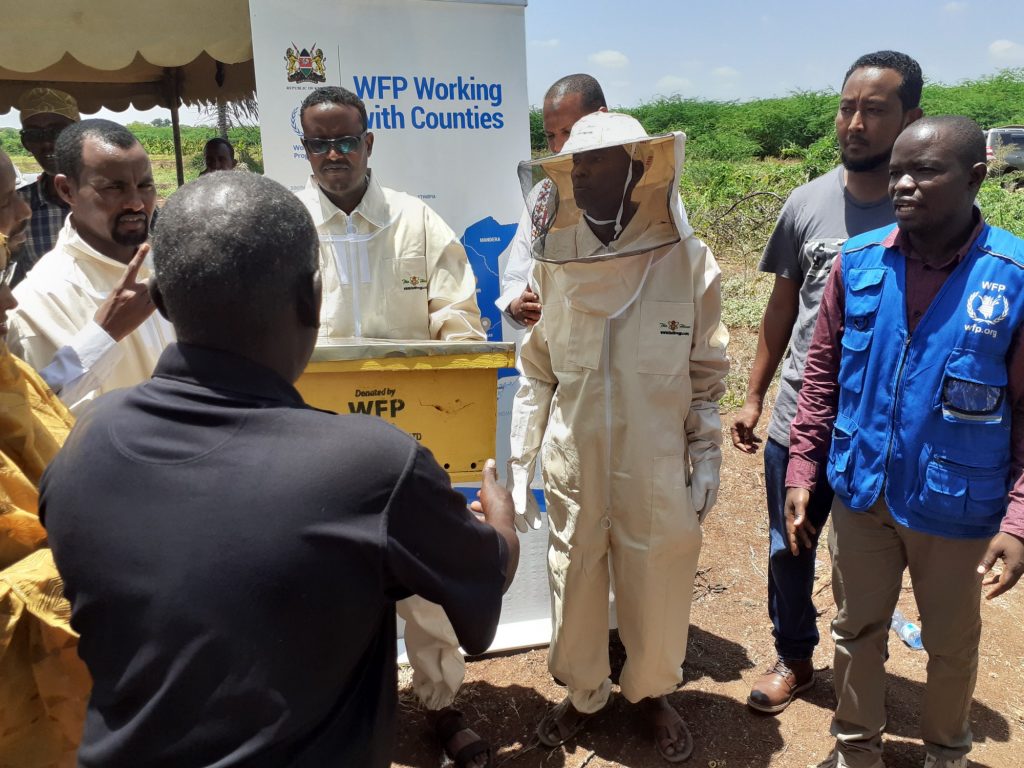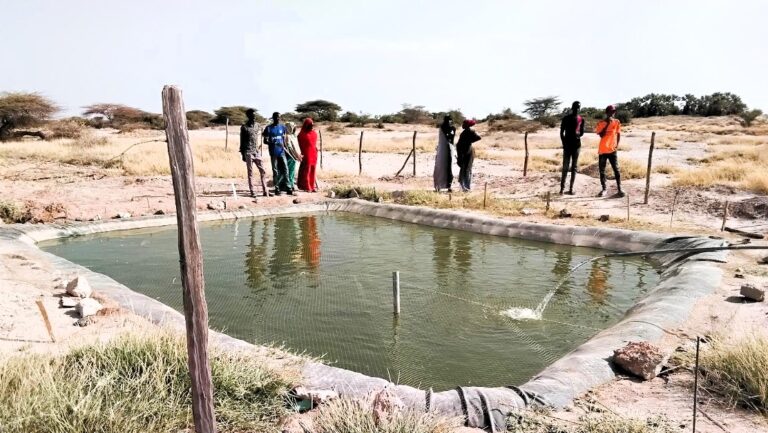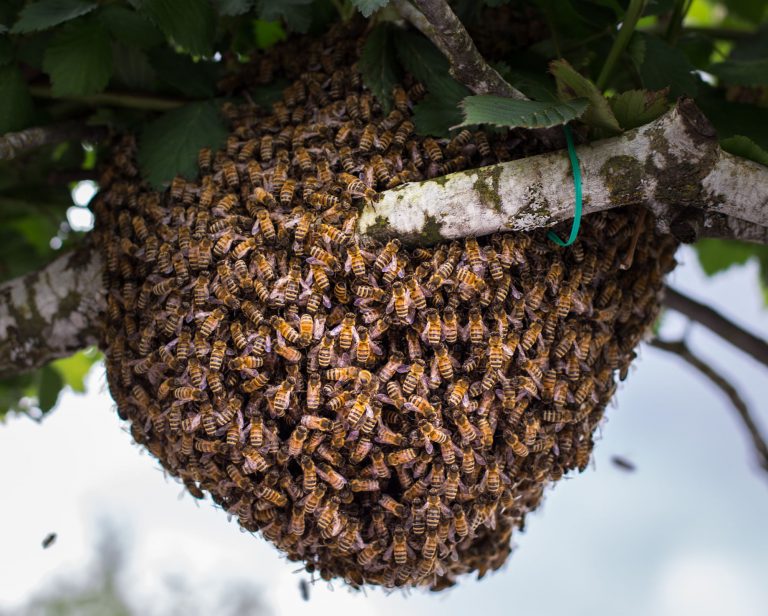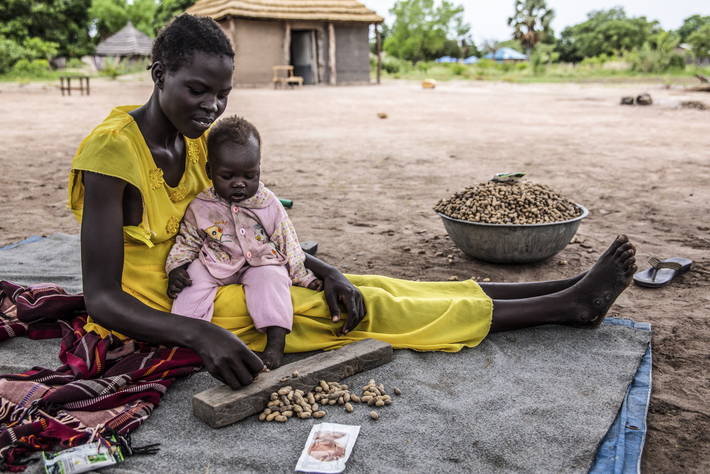By Philip Looniyo
The landscape of Garissa County, North eastern Kenya, is mostly arid, desert terrain. A harsh environment for the livestock-keeping communities who face a myriad of challenges, key among them changing climatic conditions and unpredictable weather patterns.
In addition, overgrazing has led to degradation of rangelands because of continuous overstocking of grazing-land leading to numerous resource-based conflicts. Hence pastoralists are seeking new ways of making money in order to reduce their exposure to these risks.
That is why WFP is supporting the county government’s initiative to promote and enhance beekeeping, which has great potential to generate a good steady income.
WFP has provided 260 farmers from 52 farmer groups over 1,050 modern Langstroth beehives and accessories to boost honey production and fully benefit from this highly lucrative industry.
Dasheq Farmers Group was among the first to collect the beehives. Each family received five beehives, which can produce an average 50 liters of honey per season valued at about 50,000 Kenyan shillings (US$ 500). Honey can be harvested three times in a year meaning the group can earn up to 150,000 Kenya shillings (US$ 1,500) every year.
According to the group’s chairperson Siyad Derow, the programme will help families diversify their sources of food and increase their incomes.
“My family relied on pastoralism as the main source of food and income, but in 2011 we lost all our livestock. We were forced to move closer to the banks of River Tana to practice crop farming,” says Siyad.
“I received three hives from the County Government in 2015. I harvest about five litres per hive, mostly for my family’s use,” says Siyad. “But lack of skills and equipment for handling bees and harvesting honey has limited our ability to efficiently manage this enterprise.”
The dense vegetation along the plains of River Tana and all year-round availability of water provide favorable conditions for beekeeping. Honey of high value, can be stored without perishing and is in high demand for both local and external markets.
According to the county government, a properly managed bee industry in the County can produce 100 metric tonnes of honey annually, which would translate to earnings of 30 million shillings (US$ 300,000) for the beekeepers.
“Today, I feel happy,” says Siyad. “These beehives are the key for me and my group members to harvest more honey each season and help us improve our lives.”
There are still many challenges for Siyad and other bee farmers in the county. For the groups to meet the market standards, they must start processing, labeling and packaging honey and other bee products properly.
WFP has trained frontline extension officers on modern beekeeping to strengthen their capacity to transfers skills, technologies and best practices to bee farmers in the county.
In addition to the beehives, WFP has donated six-frame centrifuge machines for honey processing, beekeepers’ suits and other accessories which will help improve the quality of the honey produced in the county. Through partnerships with the Farm-to-Market Alliance (FtMA) and The Hive Ltd., WFP links bee farmers to established honey markets to enhance commercialization of this value chain.
“WFP and the County Government have given us a lot of encouragement. We have embraced beekeeping to make a living and we will not turn back,” says Siyad.
WFP and the Garissa County Government plan to increase the number of beehives in each household to 10 by 2023, which will significantly improve households’ income, enabling them to be fully self-reliant.

Beekeeping offers an alternative source of livelihood, it protects the biodiversity and can improve the food and nutrition security for vulnerable families, contributing to WFP’s effort of helping counties achieve zero hunger.
WFP understands that the beekeeping industry has the potential to transform the lives of Kenyans through diversification of livelihoods. Over 80 percent of the land mass in Kenya is arid or semi-arid and is home to over 70 percent of all livestock. The arid and semi-arid lands (ASALs) cannot sustain the ever-increasing numbers of livestock that has led to land degradation and subsequently resource-based conflicts, which have robbed many families of their only productive assets.
In an attempt to redirect the focus from the big animals, the Government of Kenya through the Agriculture Sector Development Support Programme (ASDSP) has identified beekeeping as an emerging livelihood in the ASALs. Kenya has the potential to produce 100,000 metric tonnes of honey annually and employ thousands of women, men and youth. However, it is operating at 20 percent of its production potential.
WFP has committed, through its resilient livelihoods programme, to support interested farmers in the ASALs to diversify their livelihood options and increase their income through beekeeping. WFP is therefore providing inputs (beehives, harvesting kits, processing units and packaging materials) as well as training. WFP is further linking beekeepers to markets by engaging private sector actors.
WFP is supporting beekeeping in 11 arid and semi-arid counties in Kenya.





